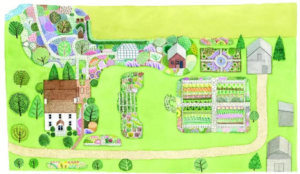Nothing helps shake the cold of late winter like leafing through colorful garden catalogs, dreaming of beautiful flower beds, and produce-filled vegetable gardens.
“This is the time of year to dream, to plan, and to start shopping,” said Lisa Foust Prater, gardening writer.
Paper catalogs are still wonderful for making wish lists, but the most well-known growers also offer their products online, and most have websites that will find items for you based on your preferences, soil, sunlight, and growing zone.
Choosing seeds or plants that fit your location helps ensure they will perform well and be less susceptible to pests and disease.
One of the best ways to get started is to draw a map of your acreage. Note where buildings, trees, and existing beds are, and pay attention to which areas are shaded and sunny.
If your soil varies throughout your property, consider noting that as well.
Also take into consideration the amount of time, energy, and money you have to spend. There’s nothing wrong with starting small. Even the smallest garden can bring immense joy.
Heirloom fruits and vegetables are gaining in popularity, and with good reason.
The seeds of these varieties have been passed from generation to generation, and today’s gardeners can enjoy the same unique, intense flavors enjoyed by their ancestors. In most cases, seeds can be saved and planted year after year.
Nearly every type of vegetable has heirloom varieties available, and the selection is amazing.
While you may have a choice between red, yellow, and cherry tomatoes at the market, your garden can provide dozens and dozens of different types, from sausage-shaped green tomatoes to pink varieties, to those with stripes.
The flavors are complex and rich and range from sugary-sweet to savory and spicy.
One of the most interesting things about shopping for and using heirloom seeds is reading the stories behind them.
Some were even carried by immigrants from war-torn countries, among their most prized possessions.
Search online suppliers for seeds that tickle your fancy, start them indoors, transplant into a sunny spot in your garden, and prepare your tastebuds for a scrumptious, old-fashioned treat.
It may be too cold to do much in the garden, but you can get a jump start on spring by starting your own seeds indoors.
By starting plants from seed, you can choose the varieties you really want, rather than having to pick from plants available at your local garden center. And watching your seeds sprout is a great cure for spring fever.
Knowing when to start seeds indoors takes some backward thinking. Your seed packet should list how many weeks the seeds will need from planting indoors to transplanting outdoors. Subtract that number of weeks from the average date of your last frost.
As a general rule, start most seeds six to eight weeks before your average last frost date. If you start seeds too early, you’ll have to keep the seedlings inside too long, and they will be weak by trans-plant time.
You can spend a lot of money on custom seed-starting containers, but there’s no need.
Cardboard egg cartons, yogurt cups, cut-down milk jugs, mini pots made from newspaper, toilet paper tubes, and even eggshells will work just fine but be sure to add drainage holes.
Biodegradable peat pots are inexpensive, and peat discs expand when wet and include the planting medium.
Start seeds in a sterile, weed-free seed-starting mix from your garden center. Plant, water, provide the required light, and keep soil temperature between 75 and 90 degrees until seedlings are up.
Loosely cover containers with clear plastic wrap or a clear cover to provide a moist environment.
After seedlings develop, thin them, keeping only the largest, healthiest seedlings. Set them outdoors for a day or two once temperatures reach 50 degrees, then transplant into your garden.
You don’t have to plant your flowers, herbs, and veggies in terra cotta pots. Be creative and put them in an old chicken feeder, wooden barrels, chimney liners, galvanized buckets, or an old boot. If it holds dirt, it’ll hold plants. Add drainage holes and good potting soil.
Choosing a container is the first part. Finding the right flora to grow it in is the fun part. For the most interesting look, remember these three categories: thrillers, fillers, and spillers.
The thrillers are flowers or grasses that grab your attention and give your container structure. The fillers are in the middle and provide color and a little more texture. Finally, the spillers trail over the side and soften the edges a little bit.
Choose interesting colors and textures and have fun with your containers.
+++30+++
